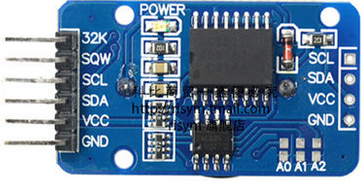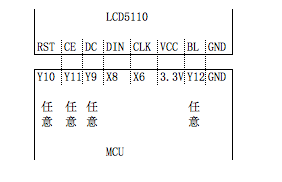
1.实验目的
1. 学习在PC机系统中扩展简单I/O?接口的方法。
2. 什么是SPI接口。 3. 学习TPYBoard I2C接口的用法。 4. 学习LCD5110接线方法。 5. 设定时钟并将当前时间显示在LCD5110上。2.所需元器件
DS3231模块一个
TPYBoard板子一块 LCD5110显示屏一个 数据线一条 杜邦线若干3.TPYBoard的SPI接口
LCD5110需要SPI接口与TPYBoard进行连接传输数据,SPI接口是在CPU和外围低速器件之间进行同步串行数据传输,TPYBoard有两个SPI接口,我们用的为SPI1接口。

4.TPYBoard的I2C接口
DS3231是I2C接口通信的,它通过I2C接口与TPYboard进行数据通讯,DS3231通过这个接口与TPYBoard进行双向通讯,进行数据传输,TPYBoard有两个I2C接口,我们在这用的是I2C接口1。

5.DS3231的接线方法
DS会我们在这只用到DS3231的SCL,SDA,VCC,GND四个针脚即可设定读出当前时间,我们用的位I2C接口1,即DS3231的针脚SCL接TPYboard的针脚X9,针脚SDA接TPYBoard的针脚X10。

6.控制5110显示屏显示6x8字符
先看一下LCD5110针脚含义吧(注意:LCD5110的针脚有些不一样的)
TPYBoard的针脚与5110的针脚对应关系如下:TPYBoard LCD5110 memo
———————————————————————————— # any Pin => RST Reset pin (0=reset, 1=normal) # any Pin => CE Chip Enable (0=listen for input, 1=ignore input) # any Pin => DC Data/Command (0=commands, 1=data) # MOSI => DIN data flow (Master out, Slave in) # SCK => CLK SPI clock # 3V3 or any Pin => VCC 3.3V logic voltage (0=off, 1=on) # any Pin => LIGHT Light (0=on, 1=off) # GND => GND 还是看不明白的话,直接上针脚编号吧 TPYBoard LCD5110 memo ———————————————————————————— Y10 => RST Reset pin (0=reset, 1=normal) Y11 => CE Chip Enable (0=listen for input, 1=ignore input) Y9 => DC Data/Command (0=commands, 1=data) X8 => DIN data flow (Master out, Slave in) X6 => CLK SPI clock VCC Y12 => LIGHT Light (0=on, 1=off) GND
7.源代码
接线ok后,并且导入font.py文件、upcd8544.py文件以及DS3231.py,编写main.py设定时间,运行main.py即可将当前时间显示在5110显示屏上。
# main.py -- put your code here!import pybimport upcd8544from machine import SPI,Pinfrom DS3231 import DS3231ds=DS3231(1)ds.DATE([16,11,26])ds.TIME([16,14,6])while True: ds.TEMP() ds.DATE() SPI = pyb.SPI(1) #DIN=>X8-MOSI/CLK=>X6-SCK #DIN =>SPI(1).MOSI 'X8' data flow (Master out, Slave in) #CLK =>SPI(1).SCK 'X6' SPI clock RST = pyb.Pin('X1') CE = pyb.Pin('X2') DC = pyb.Pin('X3') LIGHT = pyb.Pin('X4') lcd_5110 = upcd8544.PCD8544(SPI, RST, CE, DC, LIGHT) lcd_5110.lcd_write_string('Date',0,0) lcd_5110.lcd_write_string(str(ds.DATE()),0,1) lcd_5110.lcd_write_string('Time',0,2) lcd_5110.lcd_write_string(str(ds.TIME()),0,3) lcd_5110.lcd_write_string('Tem',0,4 ) lcd_5110.lcd_write_string(str(ds.TEMP()),0,5) pyb.delay(1000)